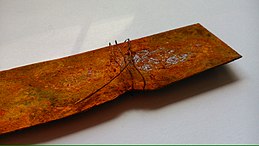


Iron oxides are chemical compounds composed of iron and oxygen. Several iron oxides are recognized. Often they are non-stoichiometric. Oxyhydroxides are a related class of compounds, perhaps the best known of which is rust.[1]
Iron oxides and oxyhydroxides are widespread in nature and play an important role in many geological and biological processes. They are used as iron ores, pigments, catalysts, and in thermite, and occur in hemoglobin. Iron oxides are inexpensive and durable pigments in paints, coatings and colored concretes. Colors commonly available are in the "earthy" end of the yellow/orange/red/brown/black range. When used as a food coloring, it has E number E172.


Iron oxides feature as ferrous (Fe(II)) or ferric (Fe(III)) or both. They adopt octahedralortetrahedral coordination geometry. Only a few oxides are significant at the earth's surface, particularly wüstite, magnetite, and hematite.
| Iron oxide | CTE (× 10−6 °C−1) |
|---|---|
| Fe2O3 | 14.9[6] |
| Fe3O4 | >9.2[6] |
| FeO | 12.1[6] |
Inblast furnaces and related factories, iron oxides are converted to the metal. Typical reducing agents are various forms of carbon. A representative reaction starts with ferric oxide:[9]
Iron is stored in many organisms in the form of ferritin, which is a ferrous oxide encased in a solubilizing protein sheath.[10]
Species of bacteria, including Shewanella oneidensis, Geobacter sulfurreducens and Geobacter metallireducens, use iron oxides as terminal electron acceptors.[11]
Almost all iron ores are oxides, so in that sense these materials are important precursors to iron metal and its many alloys.
Iron oxides are important pigments, coming in a variety of colors (black, red, yellow). Among their many advantages, they are inexpensive, strongly colored, and nontoxic.[12]
Magnetite is a component of magnetic recording tapes.
|
| |||
|---|---|---|---|
| Fe(-II) |
| ||
| Fe(0) |
| ||
| Fe(I) |
| ||
| Fe(0,II) |
| ||
| Fe(II) |
| ||
| Fe(0,III) |
| ||
| Fe(II,III) |
| ||
| Fe(III) |
| ||
| Fe(IV) |
| ||
| Fe(VI) |
| ||
| Purported |
| ||
| International |
|
|---|---|
| National |
|
| Other |
|